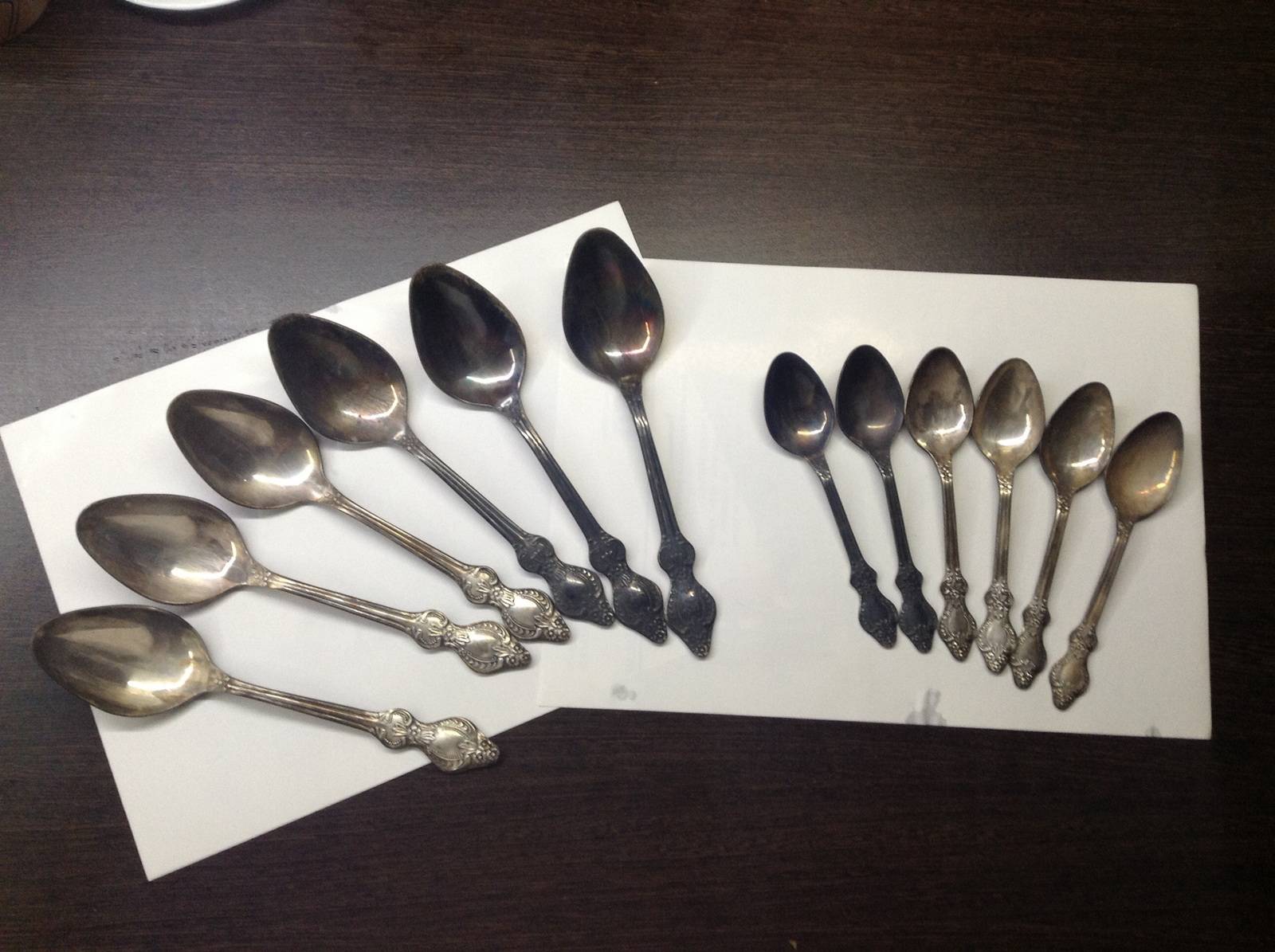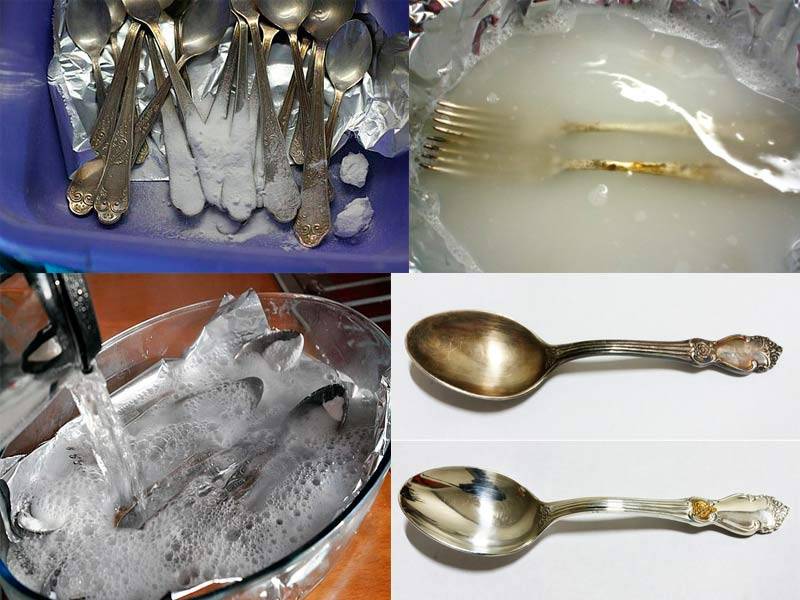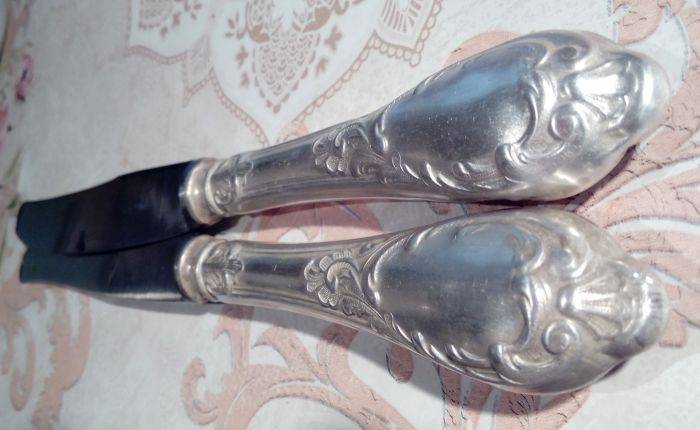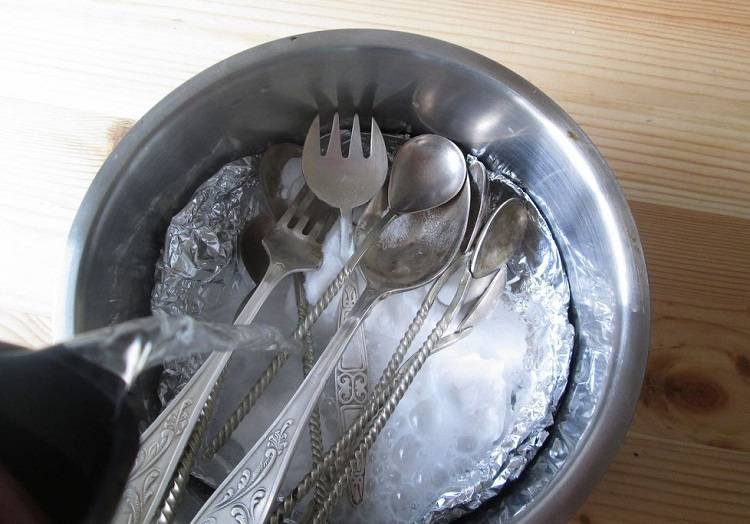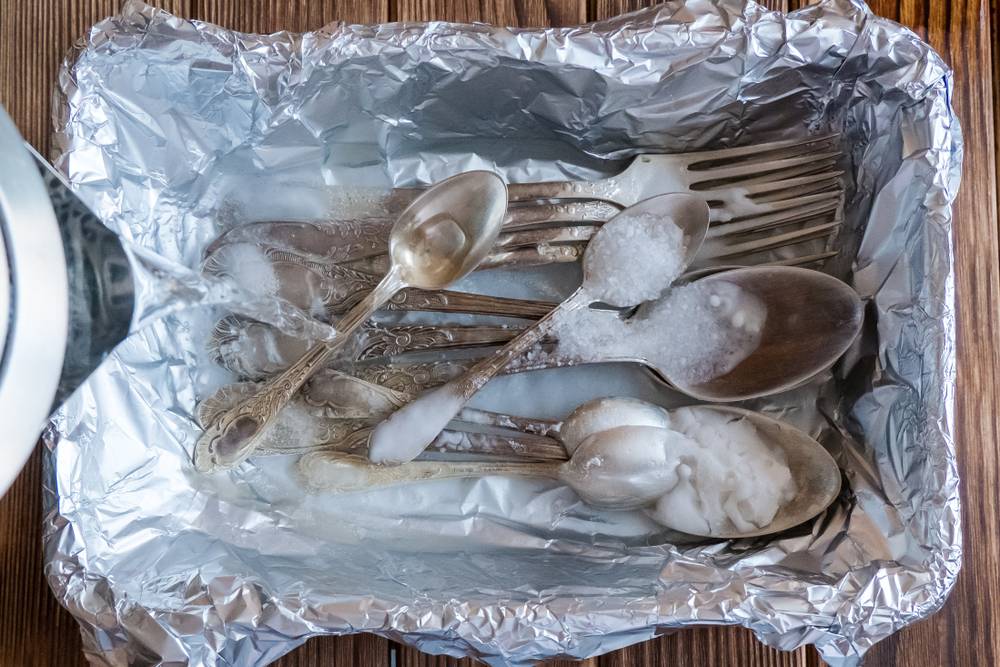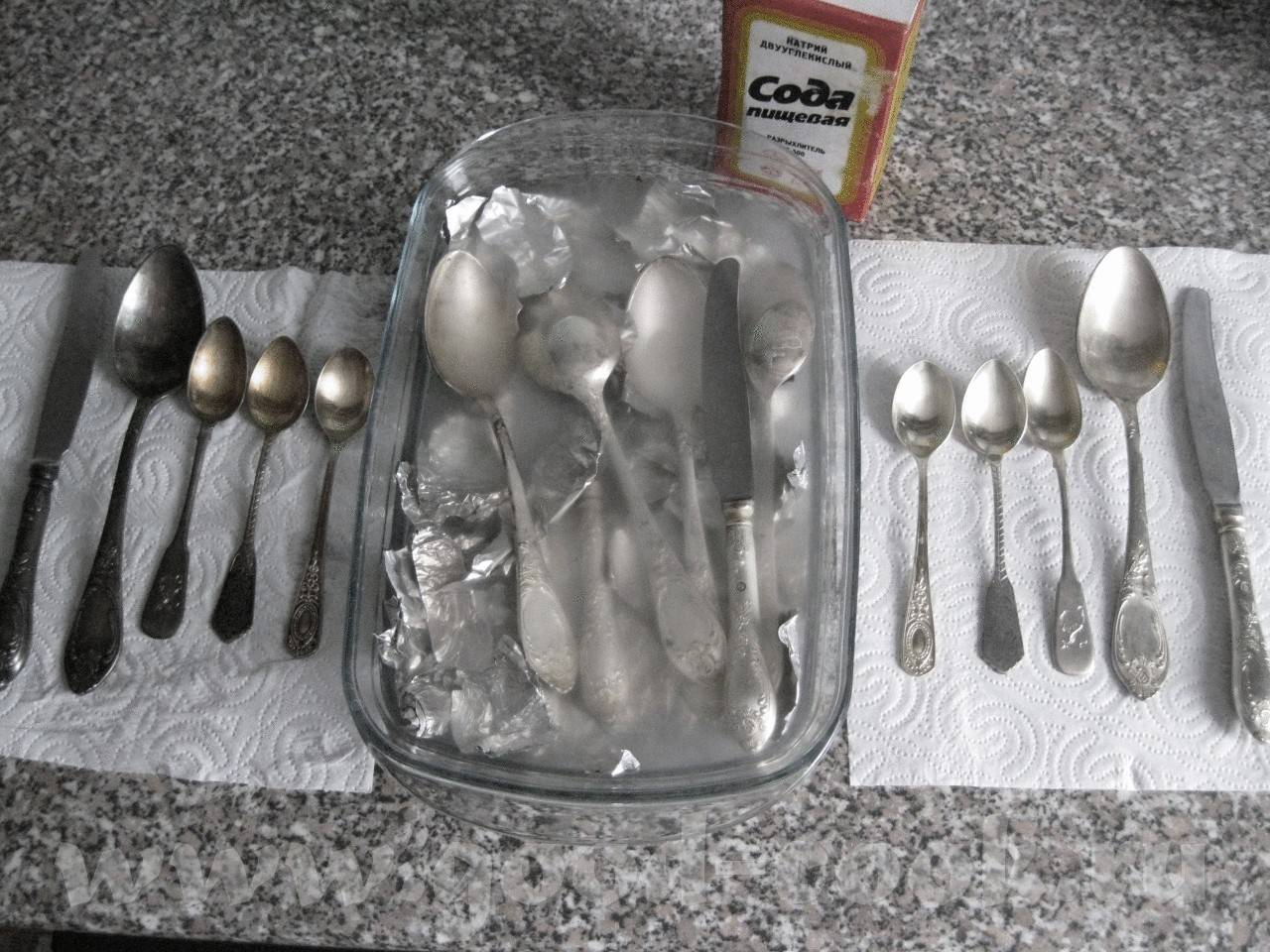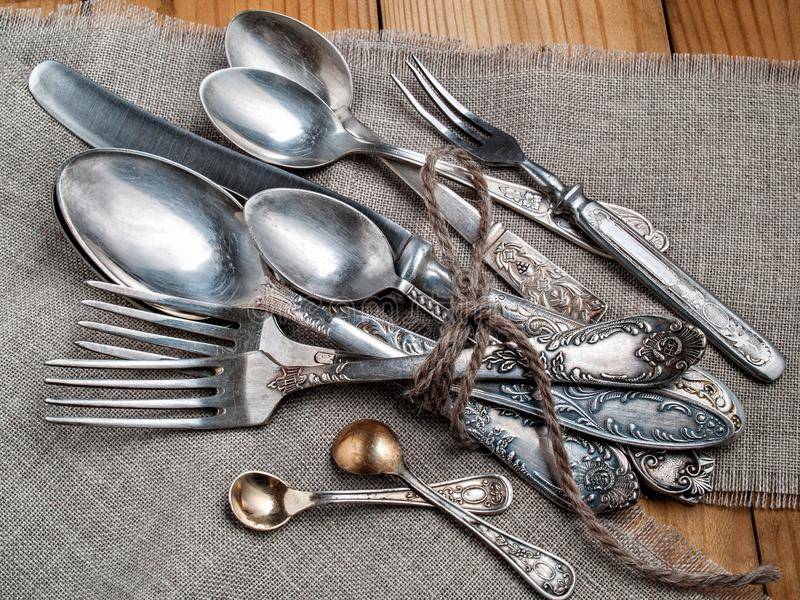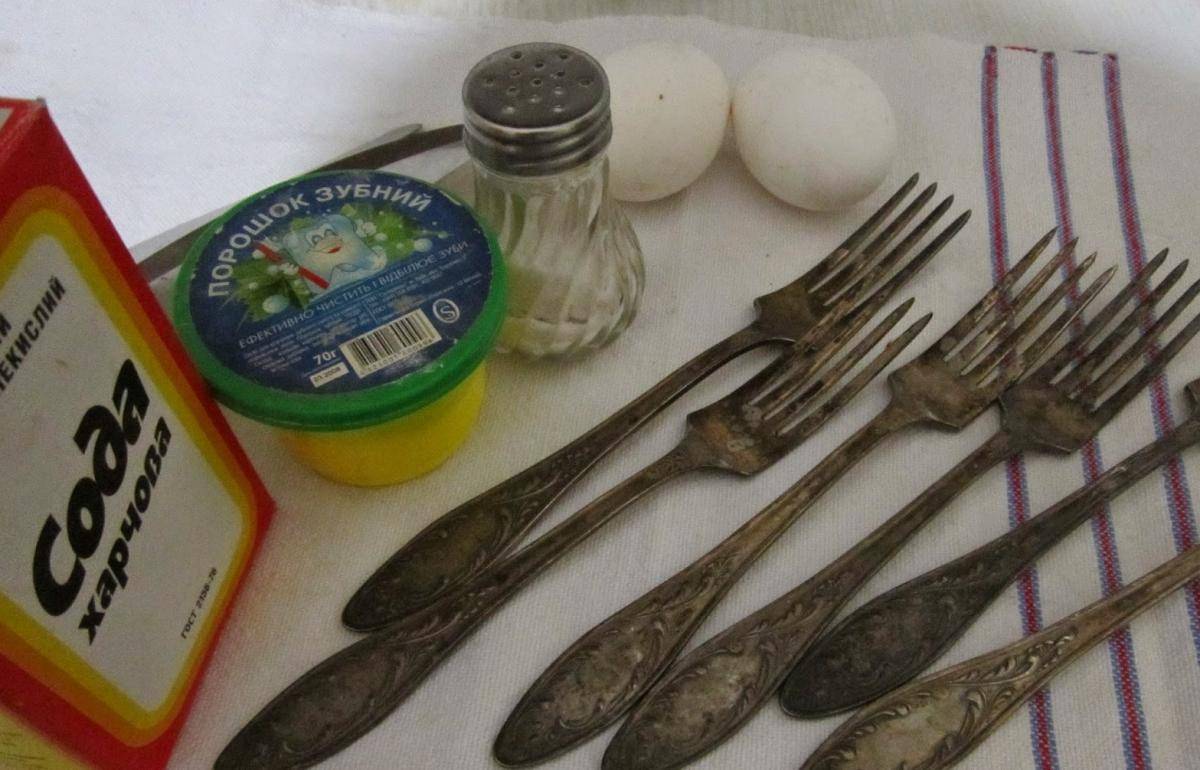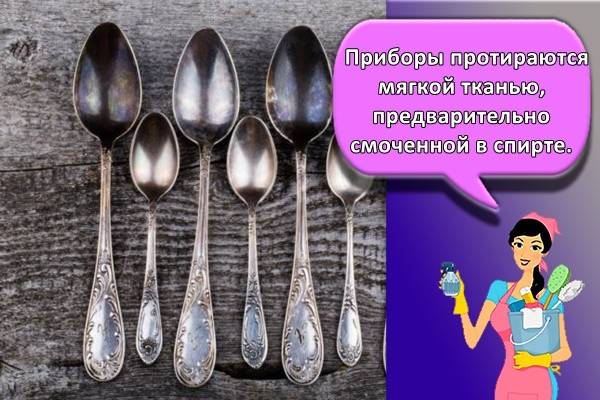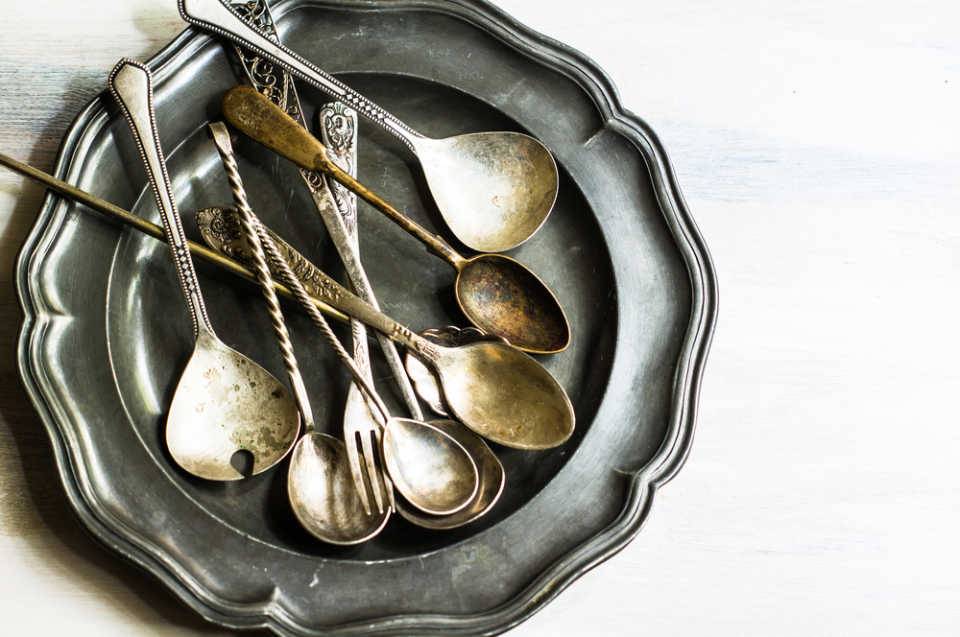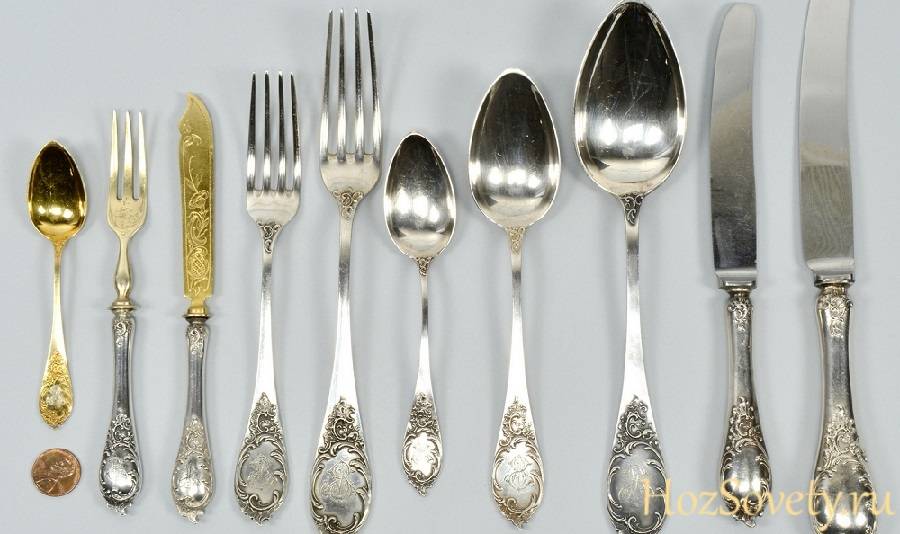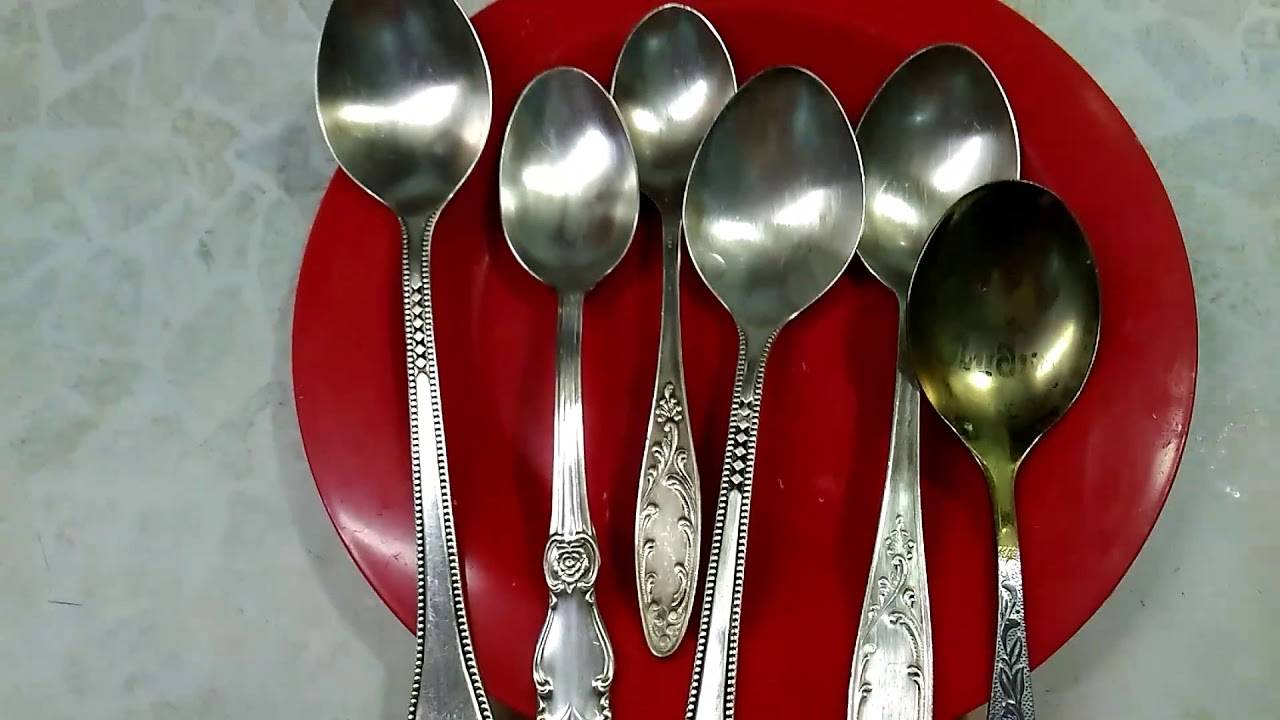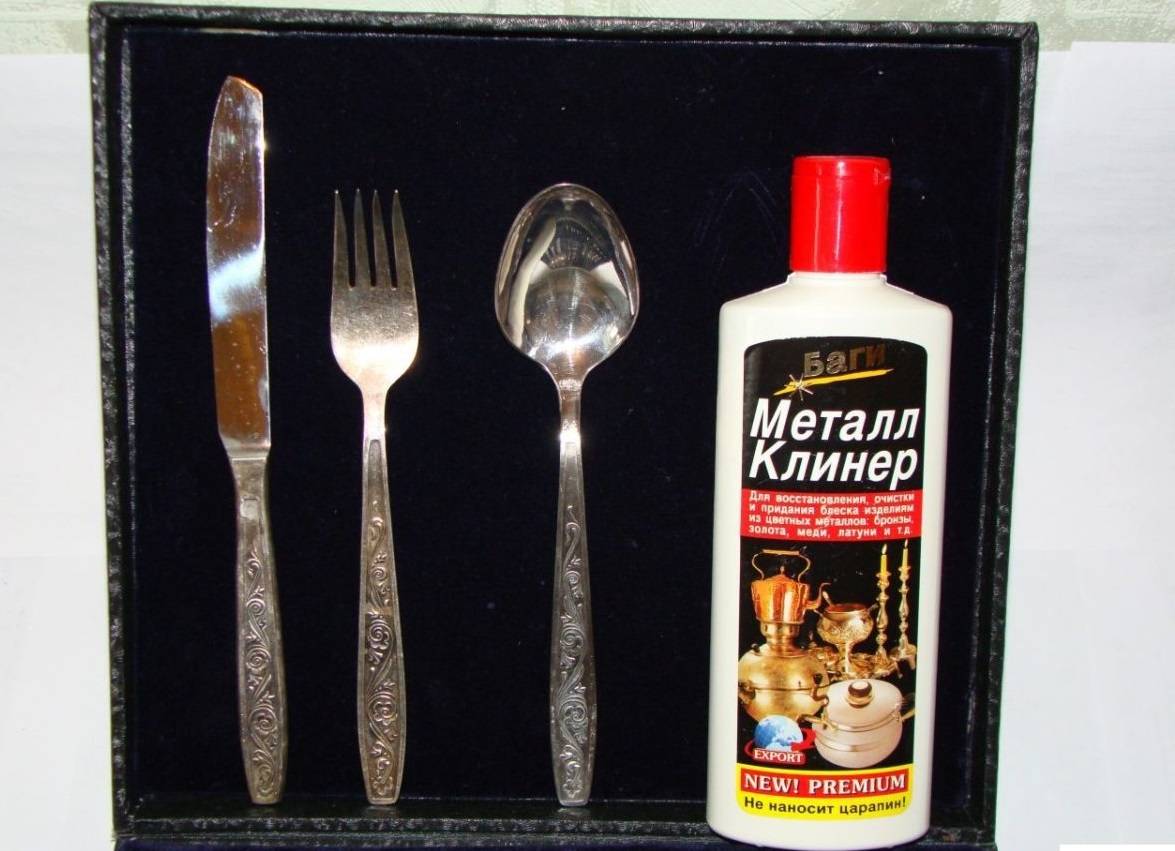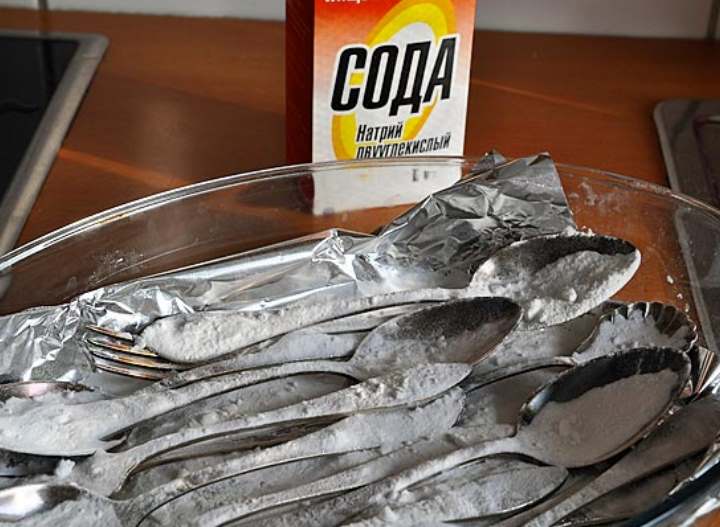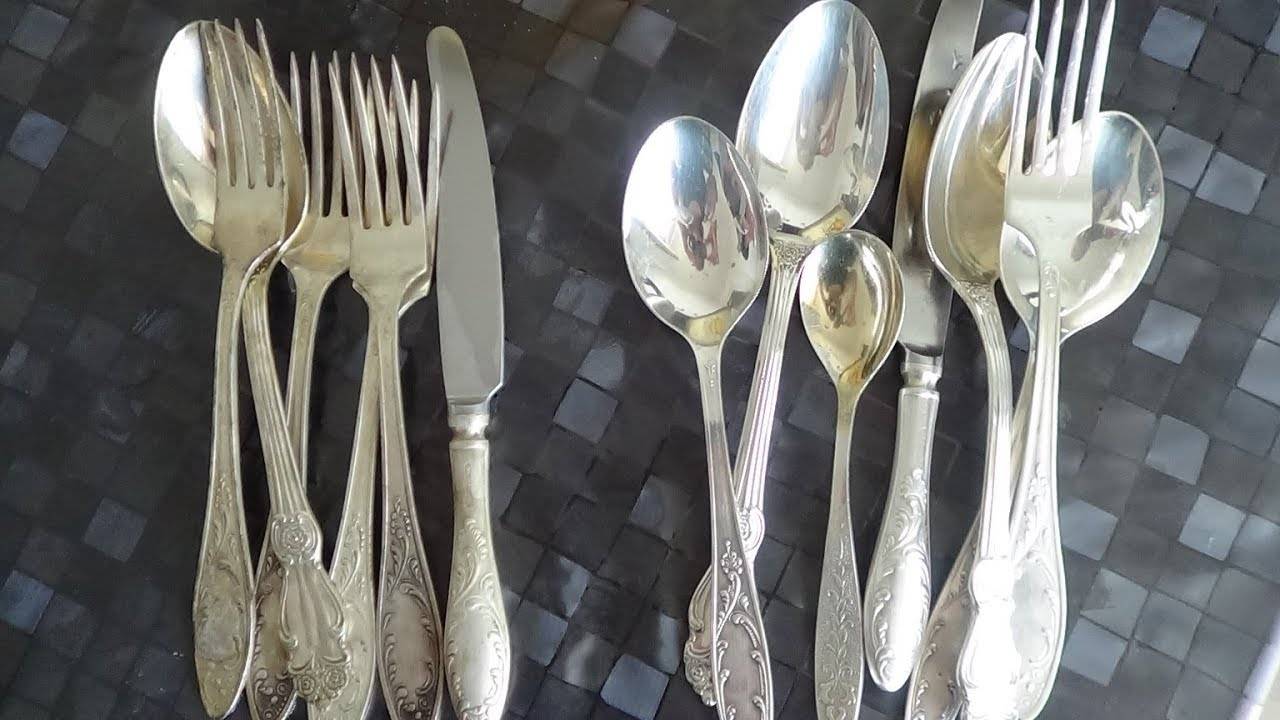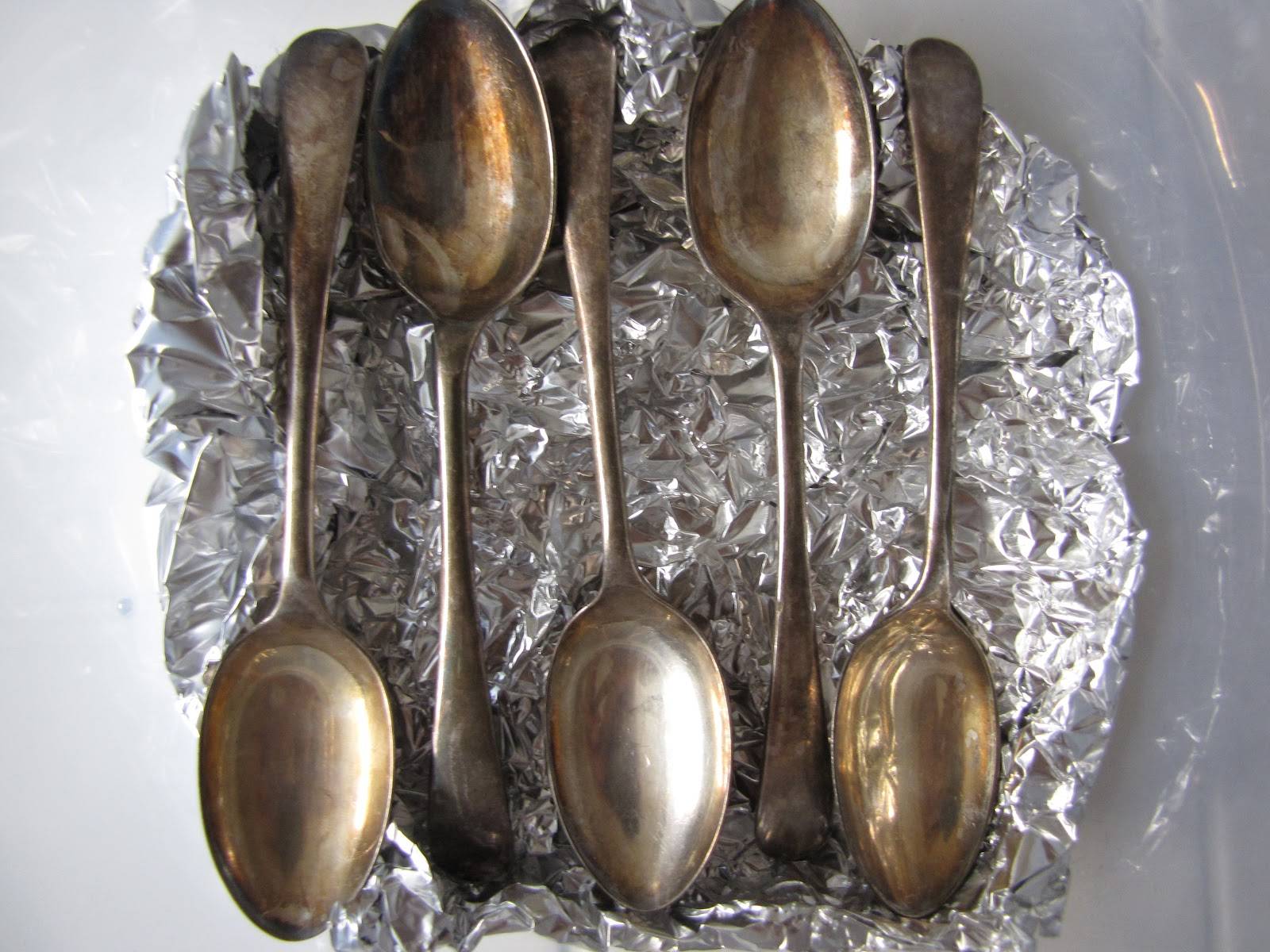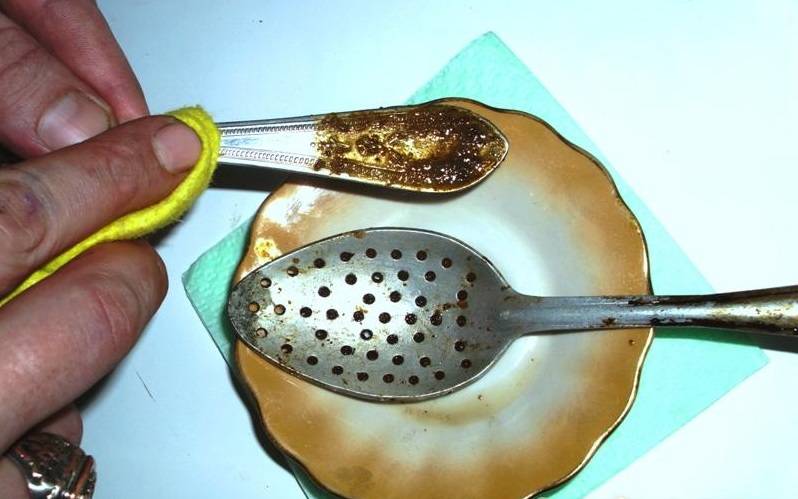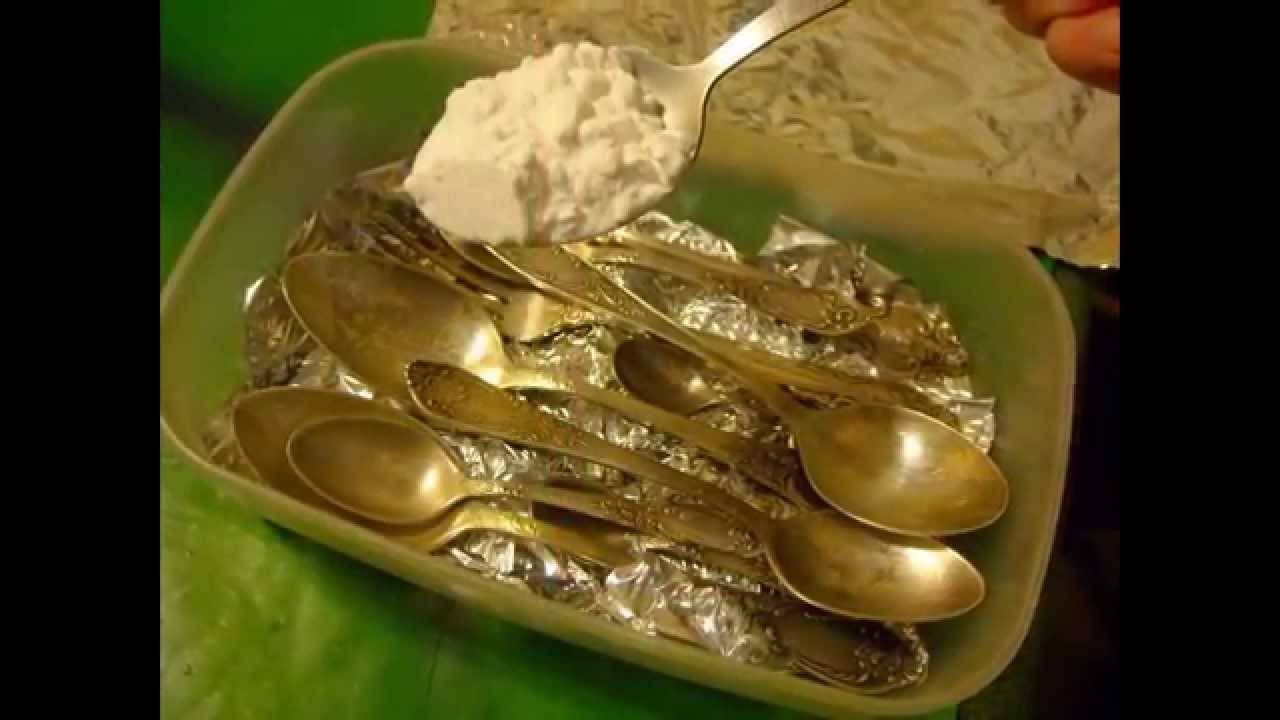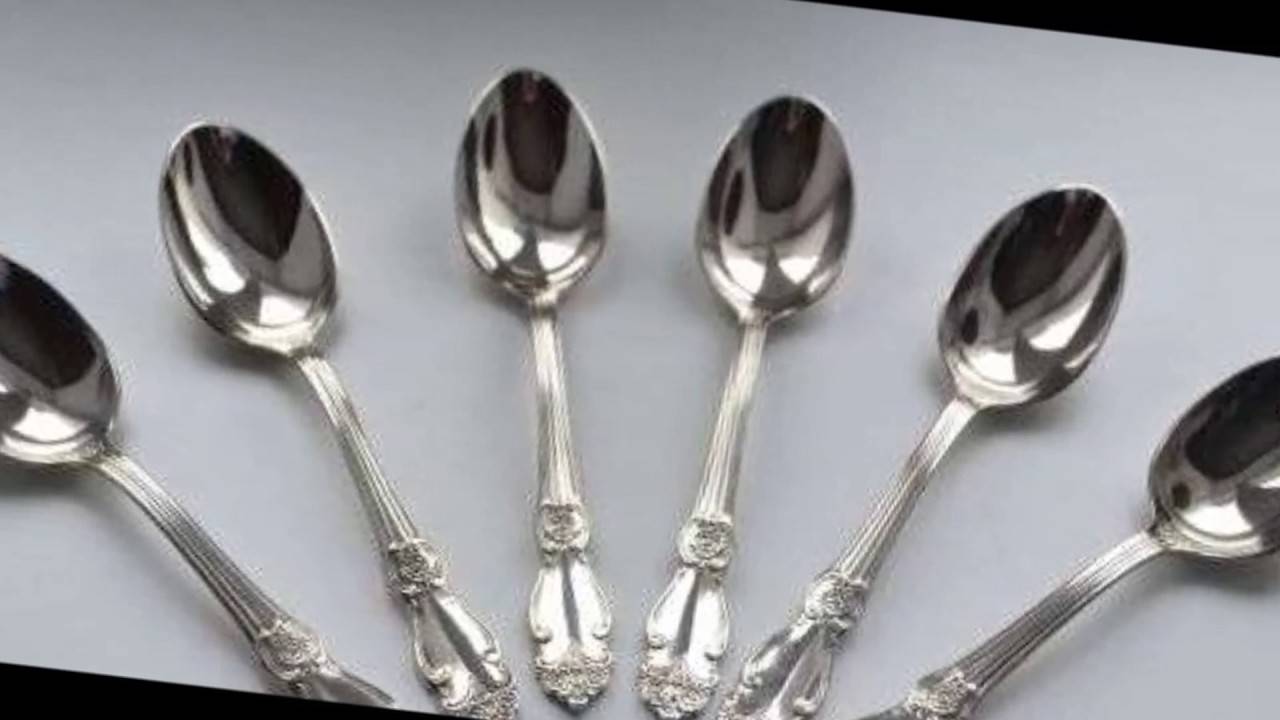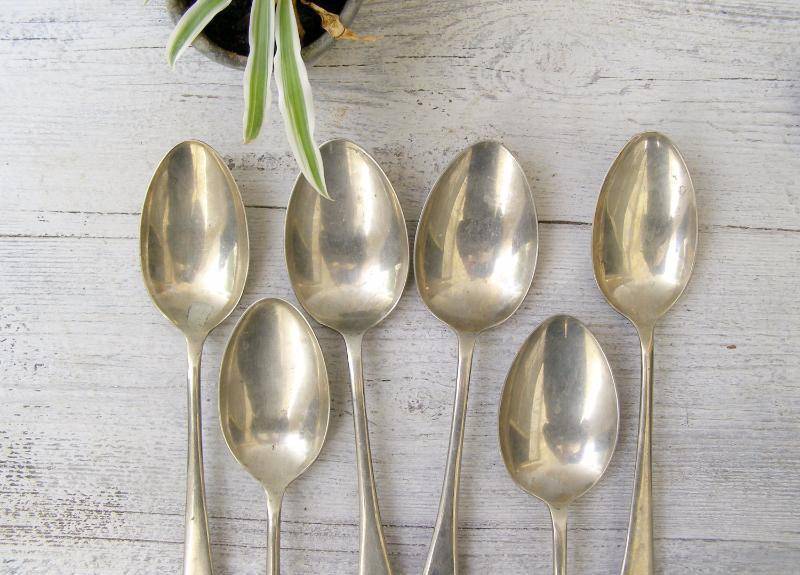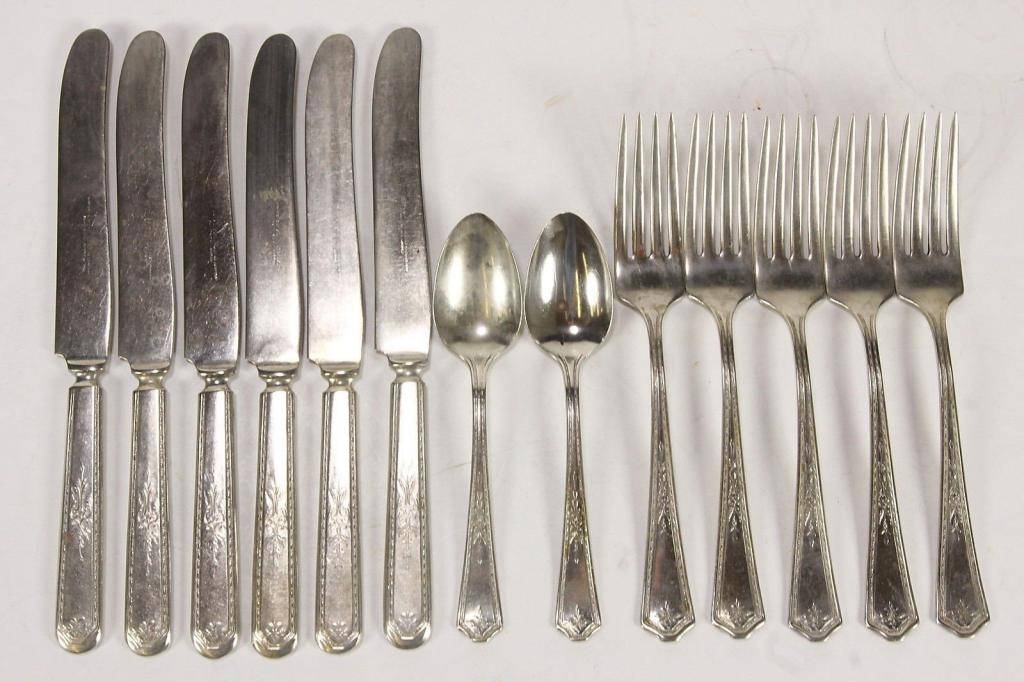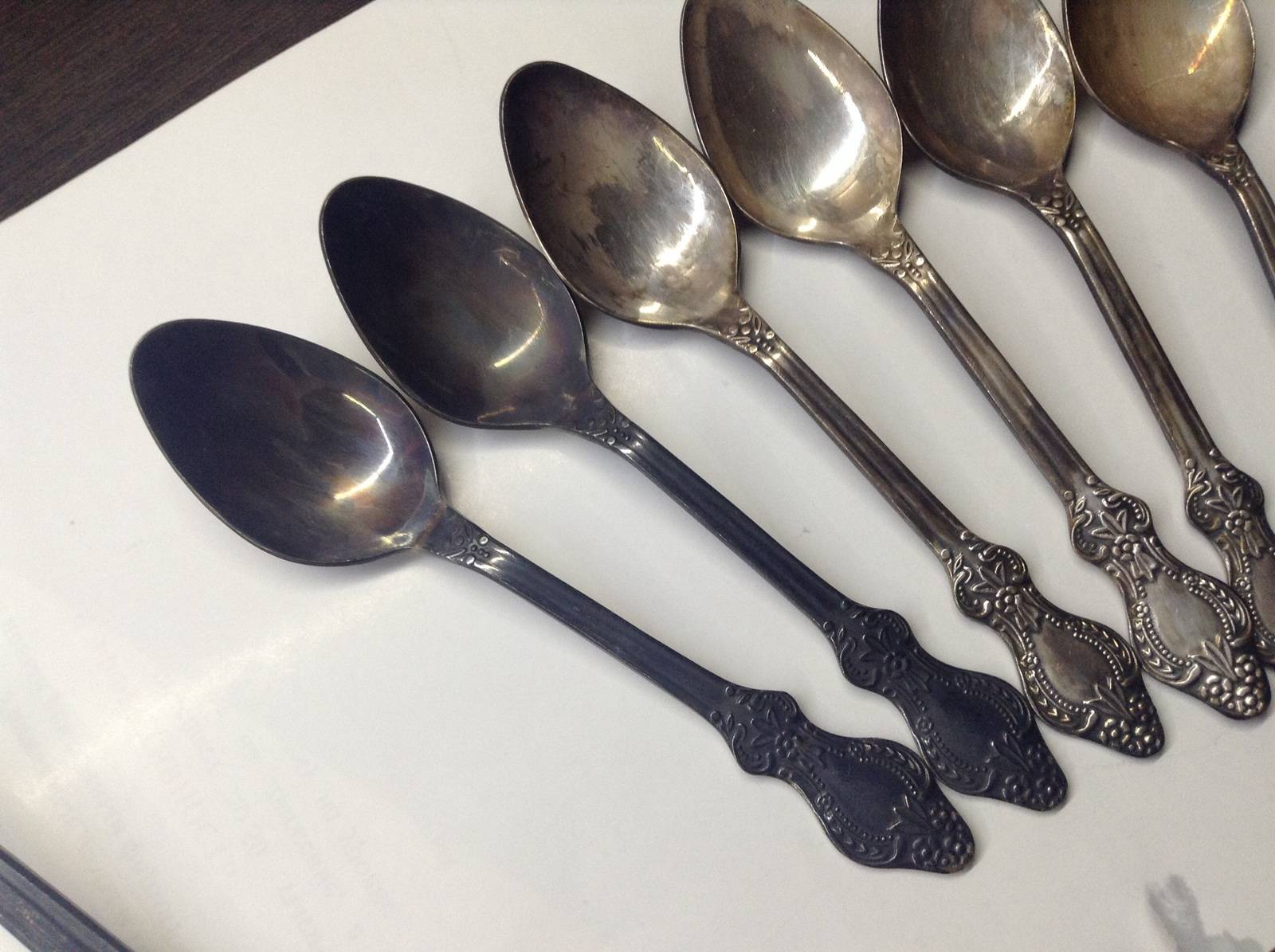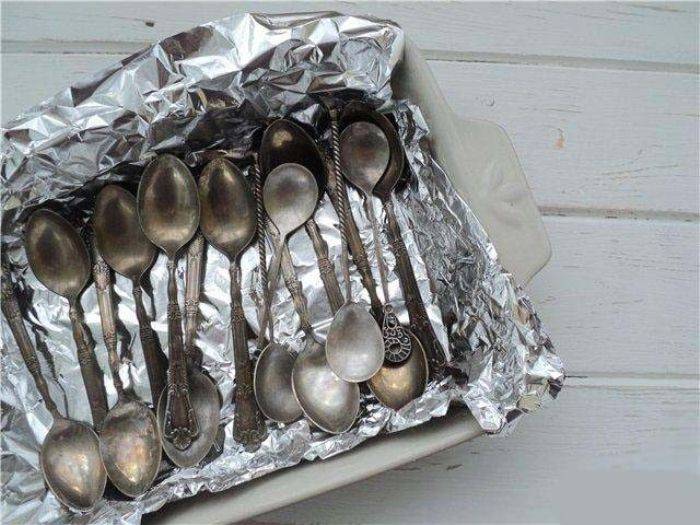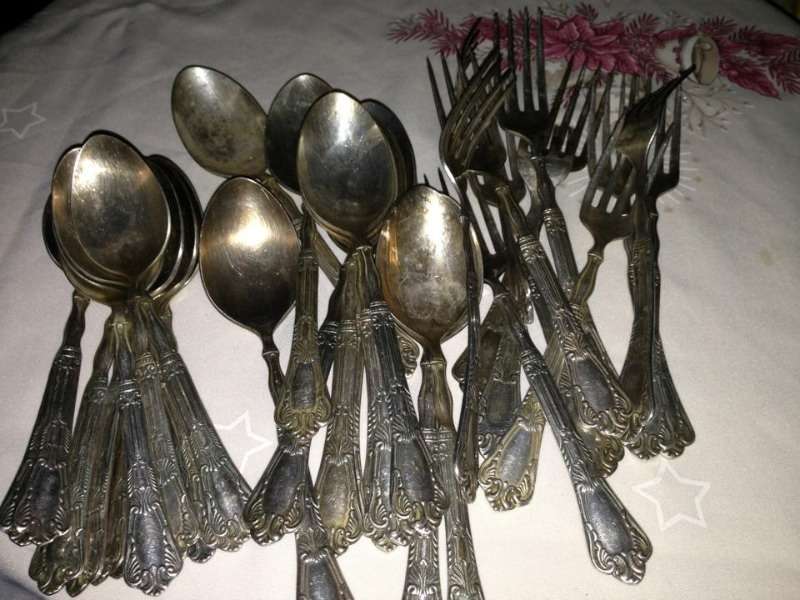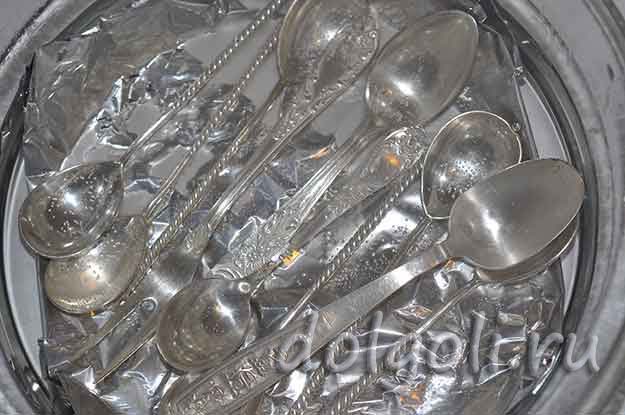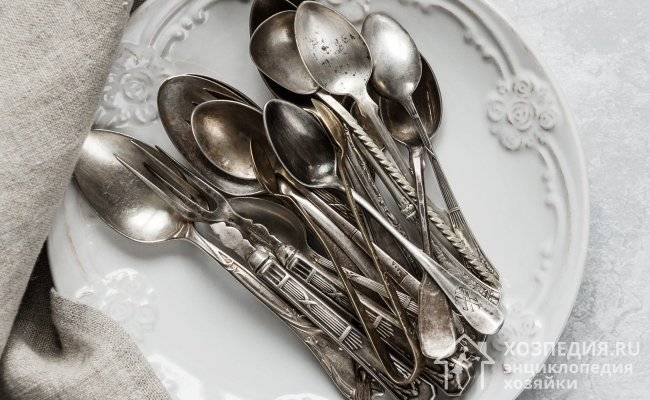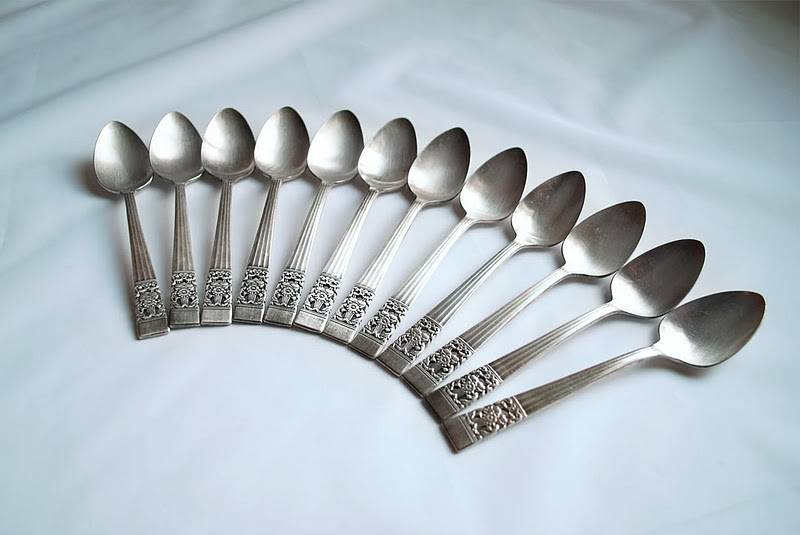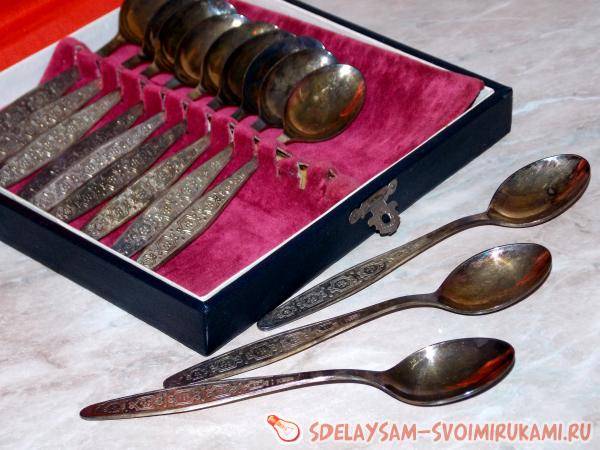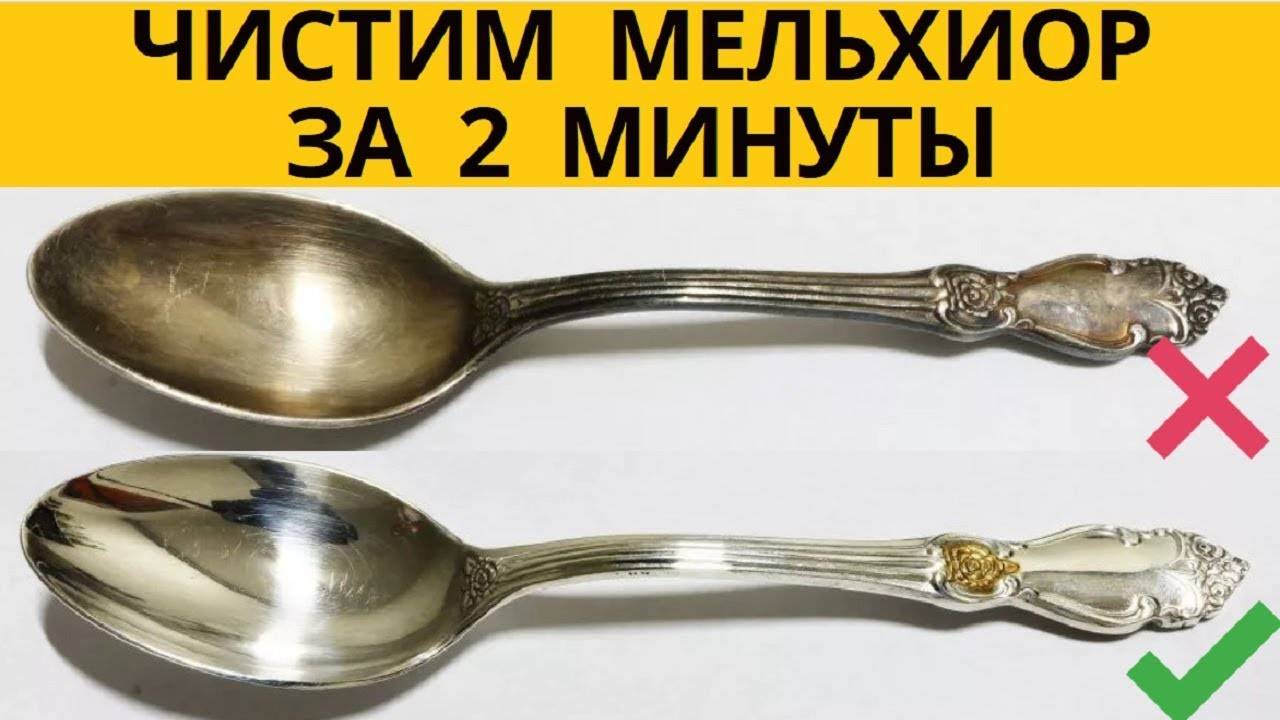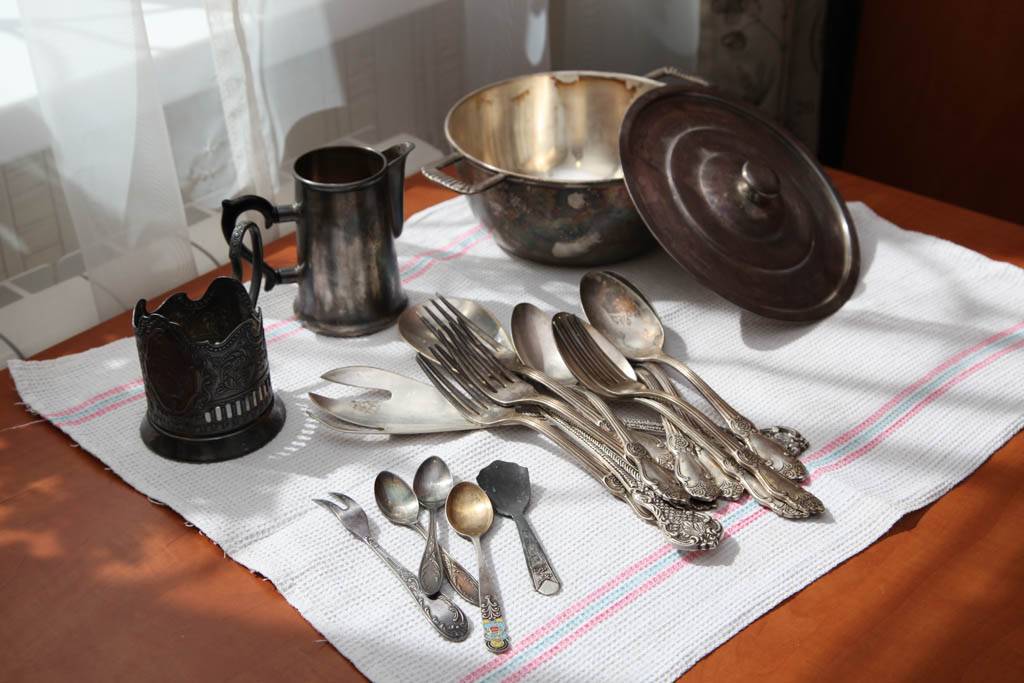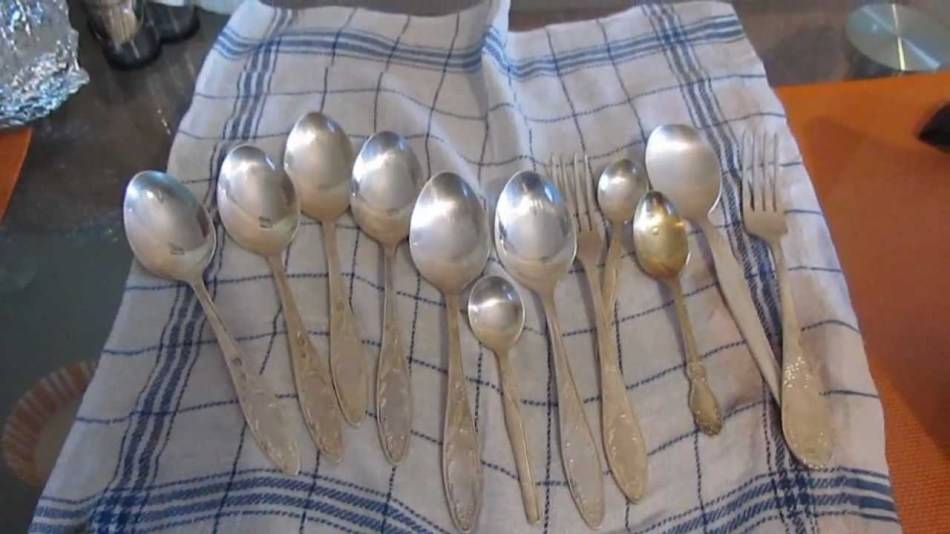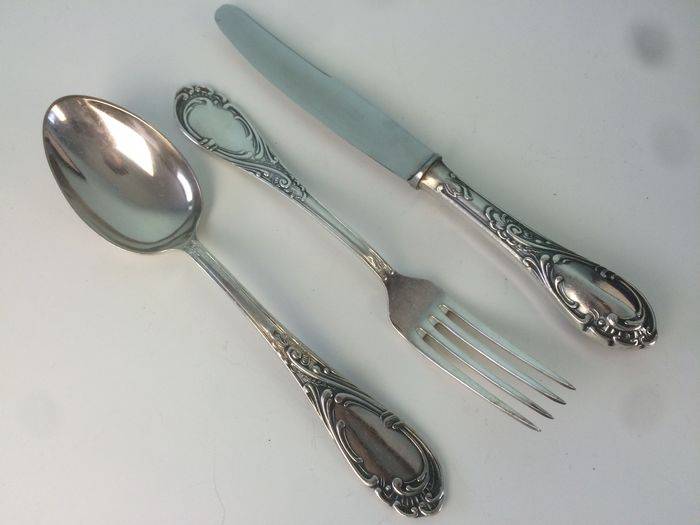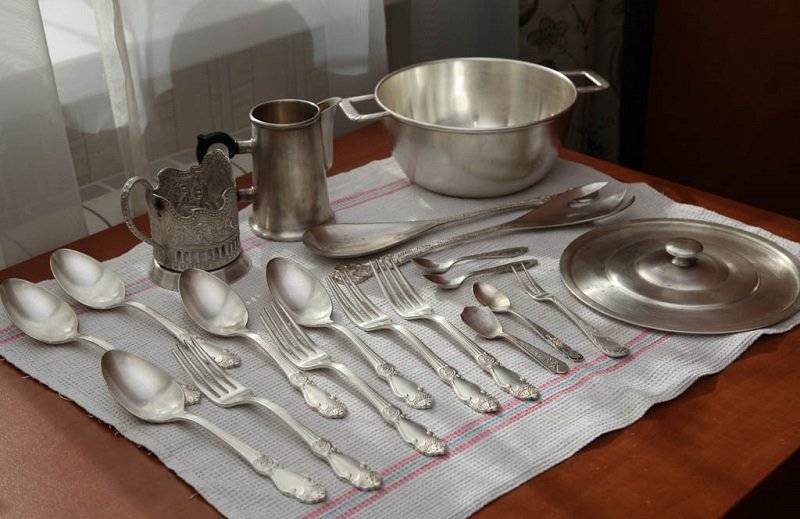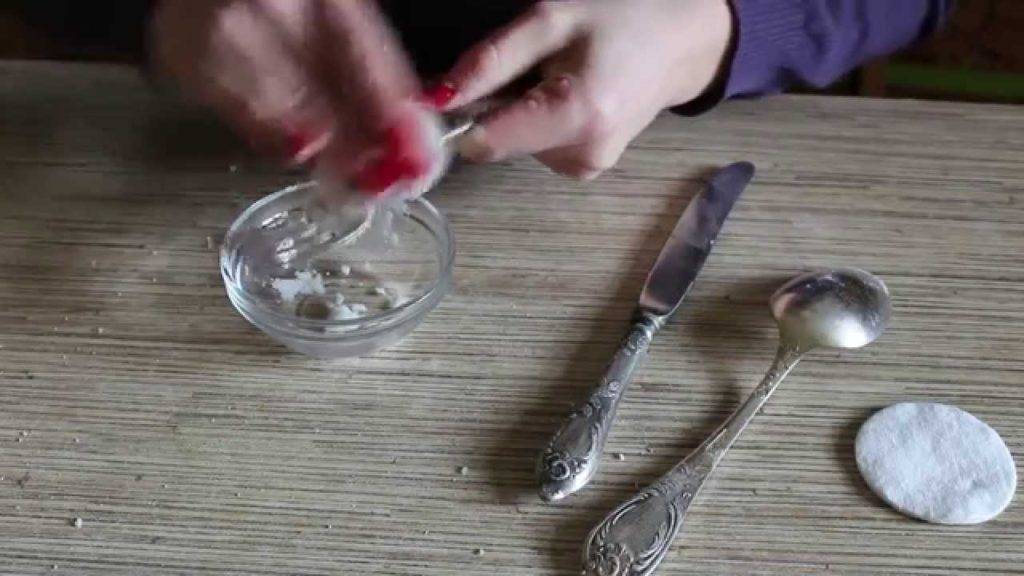Effective ways to cleanse
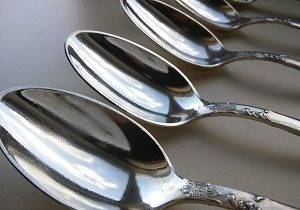
You can return the spoons from cupronickel to their original appearance in several ways:
- using household chemicals:
- folk remedies;
- with the help of professionals.
There are specialized services where products can be attributed. However, the procedure is quite expensive and not everyone will be able to resort to it. You can clean cupronickel yourself. Before the procedure, the spoons must be thoroughly washed with dish soap and wiped off with a dry napkin. There must be no grease particles on the appliances.
Chemicals
In household chemical stores, you can purchase compositions in the form of powders or gels, which will help to quickly return the shine to cupronickel spoons and remove darkening. It is better to use liquid products, they are more gentle on the surface of devices than powders.
Effective chemical compositions suitable for cupronickel:
- Metal Cleaner;
- Sanita Ultra Shine.
Note! Chemicals are applied to the surface of the cutlery and cleaned like a regular dish detergent. After using them, a thin film forms on the spoons, which protects the metal from further darkening.
Folk methods
If there are no special chemical compounds at hand, you can use proven and available tools at hand.

Salt or soda
They are suitable if the darkening is insignificant and the surface of the products has no relief. Rinse the devices in a solution of soda or salt (50 g per 1 liter of water). If dirt remains, apply a little dry product to a wet sponge and wipe the spoons pointwise.
Baking foil
Spread it on the bottom of an aluminum pan. Put cupronickel spoons on the foil. Pour water and add some baking soda. Put on fire and simmer until the devices begin to brighten. The foil will darken in this case. The procedure can be repeated if necessary.
Alcohol and ammonia
If the spoons are dull, you can use rubbing alcohol to restore their shine. You need to soak a cloth with it and wipe the products. The same result can be achieved by soaking cupronickel spoons in ammonia for a short time.
Eggshell
If the items are severely darkened, more radical cleaning methods are needed. This can be considered a decoction of eggshells. Take a shell from at least 2 raw eggs, pour it with 1 liter of water. When it boils, put the spoons in a saucepan, boil for a few minutes. Take out the products, rinse with clean water and wipe with a dry clean cloth.
Toothpaste
Apply some toothpaste or powder to a cotton pad. Gently rub cupronickel devices. Wash with water and dry.
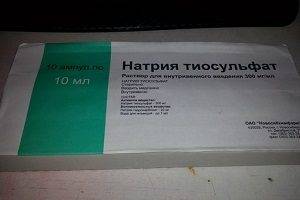
Sodium thiosulfate
The product is sold in pharmacies. Better to buy it in powder. Make an aqueous solution of sodium thiosulfate and dip cupronickel products in it for an hour. After that, wash them thoroughly with detergent, wipe.
Onion and garlic hulls
Pour water into a saucepan. Pour onion and garlic husks into it. Boil the broth and dip the spoons into it. Boil them until the result is visible. The product helps to completely get rid of darkening.
Chalk polishing
Dissolve 50 g of soap and the same amount of chalk in 1 liter of warm water. Mix all ingredients well. With a solution, use a soft sponge to polish the surface of the cutlery. Then wipe with a dry cloth.
Polishing can be prepared in another way. T 100 add ml of water 60 ml of ammonia and 30 g of chalk. Process cupronickel products with this mixture.
Home remedies
Using folk recipes, you can use simple, inexpensive means available to every housewife to carefully remove any dirt, remove unpleasant plaque, and polish.The most popular methods telling how to clean cupronickel spoons and other cutlery made of this alloy at home:
- Salt will help in the case when it is necessary to put in the proper form simple spoons, on which there are no embossed decorative elements. Crystals easily remove plaque, making the appliances shine. But it is advisable to do the processing immediately, upon detection of the first signs of darkening of cupronickel. In order not to damage the delicate surface, it is better to use fine salt.
- Soda. This remedy is suitable for old plaque. Soda can clean cupronickel, which has not been used for a long time. Processing is carried out when the devices remain slightly damp. But still, this method will not help completely get rid of the blackness in the depressions of the embossed decorations. For such products, you can look for another, more effective method.
- Sodium thiosulfate - this is the name of the medicinal substance, and it is almost the "champion" among the rest of the tools that can be used to clean cutlery at home. When an active element comes into contact with a dark coating, a chemical reaction occurs, which completely eliminates the contamination. As a result, the dishes shine like new again. Moreover, even shallow depressions and depressions are cleaned without difficulty. A piece of cotton wool must be dipped in a solution and treated with all products. The medicine is absolutely not dangerous to humans, it is easy to wash it off with a stream of running water. You can get it at a pharmacy kiosk, you don't need a prescription, and the price is cheap.
- Carbonated drinks. For those who are thinking about how to clean cupronickel in order to quickly achieve a good effect, there is one excellent tool. No wonder they say: the need for invention is cunning. Someone has guessed to use cola, sprite and other fizzy drinks as a cleanser for cutlery. Soda really shows good results, products immersed in it for several hours look like reborn.
- Water left over from boiling eggs. This is just a great option for those who do not know how to clean cupronickel spoons at home in order to do without unnecessary expenses. There is no need to drain the liquid in which the eggs were cooked, everything on the farm has to be. You just need to dip the darkened dishes made of copper-nickel alloy there and see what happens. After a while, objects will brighten right before your eyes and begin to radiate shine again.
- Metallic foil. How to clean cupronickel spoons so as not to damage them and achieve the proper result - this question is asked by many owners of antique sets. The answer is simple: foil and soda-salt solution can easily cope with the task. For two liters of water, two tablespoons of both bulk components are taken. The resulting liquid is poured into an enameled pan, foil is placed on the bottom in advance, and spoons, forks, and nickel silver knives are placed on it. All this must be put on fire and boiled for 15 minutes. Then cool the water and take out the devices, wipe dry with a soft cloth.
- Toothpaste. Everyone knows how to use a thick mass from a tube for its intended purpose, but not everyone knows that you can clean cutlery with paste. There are no special tricks, you just need to squeeze out a little paste (preferably with a whitening effect) onto an old toothbrush and carefully process every crack of darkened products. Instead of a paste, you can take tooth powder by soaking it a little in water.
- Garlic husk. Not everyone knows how to clean a cupronickel cutlery if you don't have the usual household chemicals at hand. There is no need to look for expensive and not always effective cleaning products when there is garlic (or onions) in the house. More precisely, you need a husk, which should be poured with water (the ingredients should be taken in approximately equal parts). Products are dipped into a boiled liquid and in this way the formed plaque is cleaned.
To decide which method is best, you have to try different options.In any case, home remedies will provide gentle care for the delicate surfaces of cupronickel items.
 Salt is used to clean spoons without embossed patterns
Salt is used to clean spoons without embossed patterns Soda removes old plaque
Soda removes old plaque Sodium thiosulfate tackles all kinds of dirt
Sodium thiosulfate tackles all kinds of dirt Soda removes stains and dirt quickly and easily
Soda removes stains and dirt quickly and easily The water left over after boiling eggs is also suitable for cleaning cupronickel
The water left over after boiling eggs is also suitable for cleaning cupronickel Toothpaste successfully removes dark plaque
Toothpaste successfully removes dark plaque Metallic foil restores shine to devices
Metallic foil restores shine to devices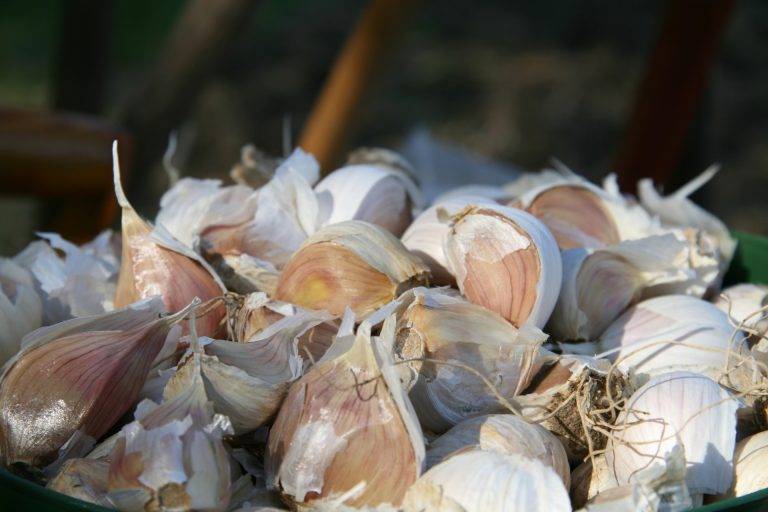 Garlic husk removes plaque
Garlic husk removes plaque
Cleaning of other products from cupronickel
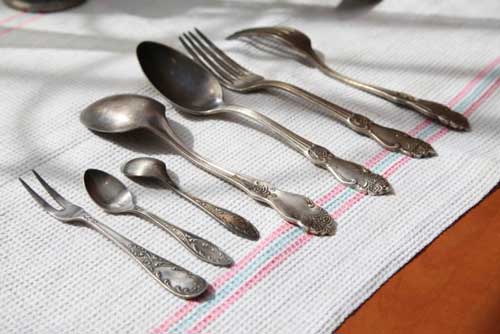
Cupronickel is used not only for the manufacture of cutlery. This unusual metal is successfully used in jewelry making. Cupronickel rings, earrings and bracelets look very impressive and are often decorated with semi-precious stones.
Cupronickel figurines, caskets, candlesticks, cup holders and other kitchen utensils are also very popular.
All these items oxidize over time, which is why an ugly dark coating appears on them, which also requires regular removal.
- Soak metal items in hot soapy water for several hours. Rinse with running water and wipe dry.
- To restore the shine of cupronickel decorations, immerse them in hot potato broth for 10 - 15 minutes, for example, after cooking boiled vegetables.
- Crush two fresh eggshells and cover with one liter of water. Add a heaping tablespoon of salt. Boil and gently dip the cupronickel chain, ring or earrings into the solution.
Turn off the heat immediately and leave for ten minutes. After that, drain everything and rinse the items with clean running water.
- Garlic and onion skins also do a good job on darkened metal. Place the decorations in a small amount of water and waste after peeling the onions and garlic.
Boil over low heat for a few minutes and cook until plaque is completely removed.
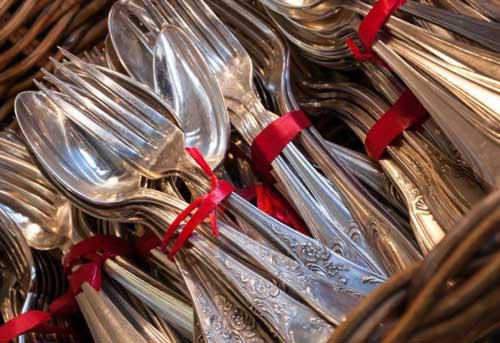
Important!
Tips for cleaning jewelry only apply to jewelry without stones. Some precious and semi-precious stones are very sensitive to hot, humid environments or to the influence of active substances such as vinegar, ammonia or alcohol.
The stones can darken, cloudy, or even change their color.
Store products for cleaning cupronickel products
For those who do not want to "invent a bicycle", the chemical industry offers a wide range of effective cleaning products for metal products. All of them can be purchased in the departments of household chemicals.
Here is a small list of the most popular brands, their comparative characteristics and the approximate cost of the product.
|
Name |
Manufacturer |
Volume |
Properties and characteristics |
Price |
|
"Metal Cleaner", liquid |
"Bugs", Israel | 350 ml | Cleans and restores the appearance of items made of cupronickel, silver, copper and brass.
Does not scratch. Ingredients: organic and inorganic acids, active polishes. |
RUB 790 |
|
Bagi. Super cream |
"Bugs", Israel | 350 ml | A versatile cream designed to clean and protect all metal surfaces.
Cleans and restores the original shine to products, dishes and jewelry made of stainless steel, cupronickel, silver, chrome, copper. Chlorine free. Does not cause allergies and is safe for the skin of the hands. |
320 RUB |
|
“Salt. For cleaning items made of cupronickel and silver ", cream |
"Aladdin" | 165 gram | Means for cleaning, restoring and protecting items made of silver, cupronickel, stainless steel.
Effectively removes tarnishing and protects against further tarnishing. Does not scratch the surface and does not destroy decorative blackening. |
140 RUB |
|
"Font. Solution for cleaning silver ", solution |
"Aladdin" | 50 ml | Eliminates plaque, oxidation, household pollution from items made of silver, cupronickel and copper. | RUB 87 |
|
Talisman |
Russia | 150 ml | Highly effective cleaner for items made of cupronickel, copper and silver.
Quickly and easily removes dirt, darkening, oxides. Returns visual appeal and shine. |
RUB 300 |
For the first time, the mention of cupronickel is found in the history of ancient China. Coins were minted from it, jewelry and household items were made. Later, the alloy came to Europe, where it quickly gained great popularity and was named "new silver".
The very name "cupronickel" is a mixture of the two surnames of the French masters Mayo and Chorier, which originally sounded like "Mayoshor". In Russian, this word was transformed into "cupronickel", as we call this beautiful metal to this day.
Useful video
Reading time ≈ 8 minutes
Cupronickel kitchen utensils, found in the kitchens of many housewives, lose their original appearance over time and under the influence of high humidity. In this article we will tell you how to clean cupronickel at home quickly and efficiently. The collected methods have already passed the test of time and show the best results.
Homemade care products: which ones to choose
Improvised means for cleaning products from cupronickel are chosen for several reasons. First, most of them are available. Secondly, recipes based on them are safe. Thirdly, the effect of their use is really there, and tangible and persistent.
To understand how to clean cupronickel, you need to determine their nature. Typically, surfaces are coated with a dark bloom. In second place in popularity are stains that look like traces of dried liquid. Less common, but there are stubborn traces of dirt and grayish-green plaque.
In the fight against stains and plaque formed as a result of damp storage of products, ordinary table vinegar will be the solution. They moisten a microfiber cloth and wipe the surface.
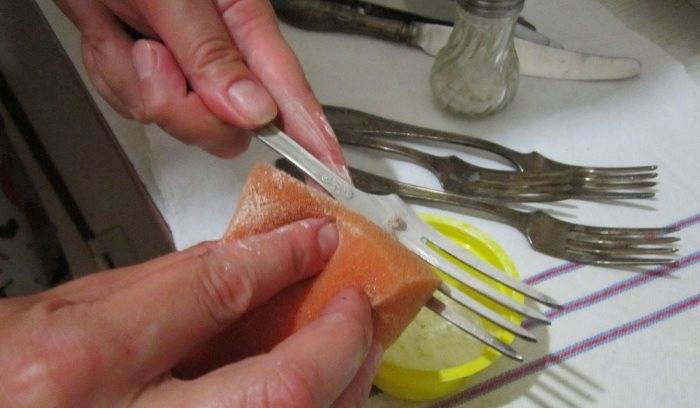
Dark spots and deposits on appliances as a result of careless use for a long time can also be cleaned with baking soda. To do this, soda is applied to a dishwashing sponge and the surface is treated without fear of damaging the top layer. Fine sea salt is an alternative to baking soda. In no case, using soda or salt to clean cupronickel, you can not choose hard brushes that can irrevocably spoil the metal.
A known way to clean cupronickel is using food foil. It is neatly laid out at the bottom of the container. The products are laid out in the dishes, soda is poured and boiling water is added. A few minutes will be enough for the alloy to react with soda and the plaque from its surface begins to move away. As soon as the cutlery and utensils are clean, they are rinsed and wiped dry.
To clean cupronickel cutlery without foil, a baking soda solution with added salt is suitable. The main thing is to maintain the water temperature for at least half an hour. Such a solution is quite effective for ordinary cupronickel products, but is not suitable for treating dishes and appliances with the addition of gilding or blackened surfaces. As in previous cases, after processing, the products are rinsed and thoroughly wiped off.

An unusual way to return newness to cupronickel products is to use garlic husks against plaque and stains. The effect can be achieved by boiling the devices along with the garlic husks for a few minutes. The saturation of the solution will depend on the number of devices requiring cleaning. The more products and the more contaminated they are, the more husk will be needed for the broth.
The power of carbonated drinks in the fight against dirt is already legendary.
How to clean with home remedies
You can deal with food debris and dirt on your products yourself using different methods.
Boiling
If the appliances are made of stainless steel, it won't take long to clean them. There is no need to clean each item separately. To remove dirt:
- Fill a large bowl with 2 liters of water.
- Add 60 g of table salt and 2 tbsp. l. soda.
- Appliances are placed in a container and put on fire.
After boiling for half an hour, the spoons and forks are taken out of the basin and wiped dry. Cupronickel products are washed in the same way, but the bottom of the bowl is covered with food foil.
Soda and citric acid
You can cope with food leftovers, clean cutlery from dirt and grease without boiling. In heated water, instead of table salt, dissolve the same amount of citric acid, pour 20 g of soda, put all the items.
Coffee grounds
Products made of stainless steel are coated with a coating, dark spots are formed on them from cruel water with impurities. Such contaminants are not washed off with boiling water, but are cleaned with abrasive materials. Cutlery is treated with coffee grounds, rinsed under the tap, and polished with paper.
Potato
Stainless steel spoons are rubbed with starch until they shine. The product is diluted with water until a slurry is obtained, which is collected on a foam sponge. Potatoes do well with dirt. The tubers are boiled together with the peel, taken out of the pan, and the devices are put in a hot liquid. After an hour, the products are taken out and dried with a piece of cloth.
They clean the stainless steel in another equally effective way. Cut raw potatoes into pieces, rub the spoons with them, leave for 30 minutes so that the starch is absorbed. The devices are washed with water.
Onion juice
To remove plaque, remove food residues from forks, destroy germs that accumulate in them, it is recommended to free the onion from the husk. Then cut the vegetable into pieces, wipe the surface of each product. The juice has an antibacterial effect, dissolves dirt.
Toothpaste or powder
For a long time, women have known what products bring back the shine of cutlery. Stainless steel will shine again if you use a simple recipe:
- Items must be put in heated water.
- Each product must be cleaned with a toothpaste brush.
- Rinse and wipe off drops.
Foil + soda + salt + boiling water
If stainless steel products are covered with a layer of fat and become cloudy, you need to take a metal bowl and put all the items in it, cover the bottom of the dishes with foil. A liter of boiling water is poured into another container, 20 g of salt and soda are added, mix thoroughly. The prepared composition is filled in a bowl with devices, which is put on the fire and boiled for 20 minutes. Products are washed with slightly cooled boiling water and polished to a shine with a towel.
Mustard and soda
To clean cutlery from old plaque, food residues, 3 liters of hot water are poured into a bowl. Pour three tablespoons of soda and mustard there. A stainless steel is immersed in the composition for half an hour. The remaining dark spots are removed with a toothbrush. Products are rinsed and dried.
Lemon juice
If stainless steel appliances have lost their luster, old dirt is poorly cleaned, it is worth using another method. Items need to be wiped with a slice of lemon and polished with a woolen cloth.
Wood ash
Aluminum products are washed with vinegar, acid. Items that have not been used for a long time are washed with hot water before being placed on the table. The remaining plaque is well cleaned with wood ash.
Ammonia
Ammonia, which is used for inhalation and other medical procedures, helps to restore shine to products, wash away dirt and grease. One part of the ammonia is poured into a jar or glass, 10 hours of water are added. They put objects in the composition, leave them until they are cleaned of dirt. The devices are rinsed under the tap, wiped off with a towel.
chalk
The handles of knives and forks made of cupronickel are often decorated with patterns in which, in the absence of proper care, microbes accumulate, and plaque is also formed. Chalk is crushed into powder and carefully rubbed into problem areas, washed off with plain water.
Gruel from activated carbon tablets
The adsorbent preparation, which is stored in the home medicine cabinet and is used to eliminate vomiting caused by food poisoning, perfectly cleans devices made of metals and alloys.
Five tablets of activated carbon are crushed in a mortar, combined with water, the resulting gruel is rubbed with stainless steel and cupronickel.
Can silver spoons be washed in the dishwasher
Silverware is not dishwasher safe. Features of automatic washing (prolonged exposure of metal in water, mechanical action, air drying) significantly reduce the service life of cutlery made of noble material. In addition, most dishwashing detergents are harsh and contain alkalis, chlorine, and other components that will speed up the oxidation of silver. If you want to keep the products in their original form for a long time, then you need to wash them only by hand.
 Silverware is not dishwasher safe.
Silverware is not dishwasher safe.
Remember that proper use, storage and cleaning of your silver cutlery will help preserve the appearance of your items. Metal can be cleaned not only with expensive means, but also with time-tested methods using vinegar, soda or toothpaste.
After cleaning, it is important to use the appliances correctly in order to avoid darkening again.
Methods for cleaning cupronickel
Cleaning cupronickel from blackness at home can be done in several ways. The choice of method and product depends on the type of product and the degree of darkening. For cleaning, you can use cleaning agents, abrasives or foil. Next, we will consider how to clean cupronickel and what is needed for this.
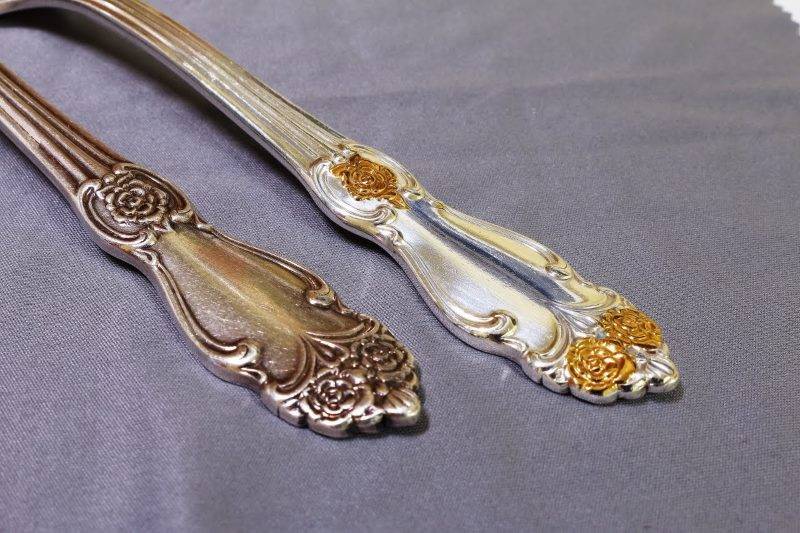
The result of cleaning cupronickel
Cleaning cupronickel products with foil
The use of foil can be combined with the use of baking soda and salt. Place the foil on the bottom of a saucepan or similar container. On the foil, you need to lay out the devices and fill them with water so that it completely covers them. The use of baking soda and salt will help get rid of the stubborn dirt that has accumulated in the micropores. You can add about three tablespoons of each substance.
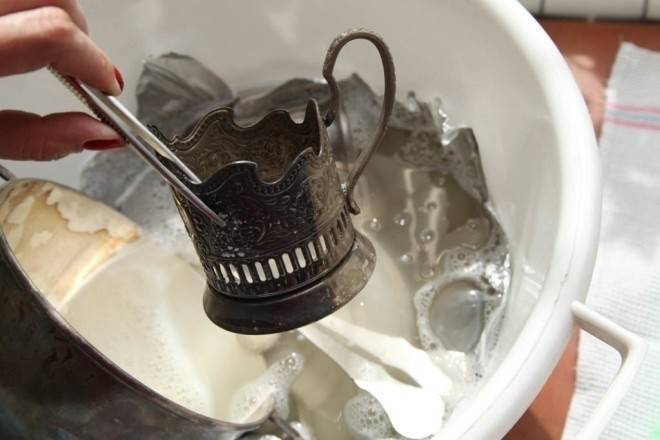
Cleaning cupronickel using foil
Then the water needs to be boiled and kept on fire for about 20 minutes. The high temperature will not affect the alloy of copper and nickel in any way, you should not worry. After the required time has elapsed, the pan must be removed from the heat and left to cool completely, without removing the appliances from the water.
After cooling, the cutlery can be removed from the water and rinsed under running water.
It is very important to wipe the products dry with a dry towel. So that the evaporated moisture does not leave new stains
Foil cleaning is a fairly effective tool that can also be used as part of a coin cleaning package.
Use of means for cleaning cupronickel industrial production
The development of the chemical industry allows the use of special cleaning agents made in the form of gels, solutions or powders. Such funds are quite effective, allow you to make less effort and time than using folk remedies and methods.
The most optimal is the use of liquid products and dry cloth. You can use special napkins pre-impregnated with the product in production. Abrasive cleaning powders are just as effective, but they can scratch the surface and are rarely used for cleaning cutlery.
Some products create a protective film on the metal surface. Such a film protects against repeated darkening and damage to products. Therefore, it is recommended to use special gels to restore the appearance of old cutlery.
Darkening with vinegar and baking soda
Vinegar and soda are easy to find in any kitchen, so they are primarily suitable for cleaning.
Soda is used in the form of a solution.For 1 liter of water, add 50 grams of baking soda. With the resulting solution, you can rub the devices with a napkin, or rinse them in a container. After cleaning, the product must be rinsed in clean water and wiped dry.
Vinegar should be used in the same way. The solution is prepared by adding a teaspoon of vinegar to a glass of clean water.
Such means will not help to cope with old dirt that has penetrated the micropores of the alloy; for periodic cleaning of spoons, it is perfect. Its advantages are the simplicity and affordability of cleaning products.
Preparation of a decoction for cleaning cupronickel
At home, you can prepare decoctions based on various substances that can be used to clean cupronickel. Eggshells, potatoes, or garlic skins are usually the basis.
A decoction based on eggshells is a fairly effective remedy that can fix even old stubborn dirt. It is prepared by adding shells from two eggs to one liter of boiling water. Cupronickel products need to be dipped in a boiling broth for a few minutes. After that, they can be taken out and rinsed with running water.
A decoction of garlic husks is prepared in a similar way. The effectiveness of the product depends on the amount of husk. The duration of boiling spoons and forks depends on the degree and age of the contamination.
Potato broth is the least effective but gentle on coatings. Therefore, it is recommended for use when cleaning products with gilding or blackening.
The use of ammonia
A solution of ammonia is prepared by adding 2 tablespoons of alcohol to half a liter of water. Polishing cutlery with such a solution can quickly clean up old dirt. You just need to wipe the forks or spoons with a sponge with applied solution.
There are many other ways and methods for cleaning cupronickel, but the above are quite enough for a quick and easy cleaning.
How to clean cupronickel products
For regular care of cutlery made of this alloy, use:
- soda;
- ammonia;
- shell of eggs;
- foil;
- chalk;
- toothpaste.
Cleaning cupronickel with soda or ammonia
For the simplest cleaning method you will need:
- 50 g of soda or 50 ml of ammonia;
- 1 liter of warm water.
Operating procedure:
-
Dissolve baking soda in warm water.
-
Wash the appliances in a baking soda solution.
-
Rinse thoroughly with cold water.
- Wipe clean appliances dry.
You can also use ammonia instead of baking soda. Both of these products are good for cleaning minor dirt from spoons, forks and knives. The dull cupronickel, washed in this way, will acquire a soft sheen.
Eggshell decoction for heavily darkened products
The method is effective even for the most stubborn stains. You will need:
- the shell of two chicken eggs;
- 1 tbsp. l. table salt;
- 1 liter of boiled water.
Cleaning procedure:
- Pour water into a flat, shallow dish and set on fire.
-
Bring the water to a boil, add the shell, previously crushed into powder, and salt to it.
-
Dip the cutlery in hot water and boil for two minutes.
- Remove the appliances, rinse and dry with a soft cloth.
How to get rid of darkening with food foil
For this cleaning method you will need:
- food foil;
- 3 tbsp. l. table salt;
- about 1 liter of water.
Operating procedure:
- Place food foil on the bottom of a saucepan and place cutlery on top of it.
-
Fill the container with water so that it completely covers the products, add salt.
- Place a saucepan with utensils on fire and bring to a boil. Simmer for about three minutes.
As a result of the chemical reaction that occurs during boiling, the food foil darkens and the cutlery brightens. If there are strong darkening on cupronickel, repeat the procedure again.
Video - how to clean cupronickel devices using foil
Chalk polishing
The most common chalk will help to cope with small dirt and polish cupronickel products to a shine:
-
Grind it into powder.
-
Add a little water to make a viscous gruel.
- Apply the mixture to a soft, lint-free cloth and buff the utensils.
If you don't have chalk on hand, use a non-abrasive toothpaste that contains silicon oxide: apply it to a moistened cotton pad and wipe the items.
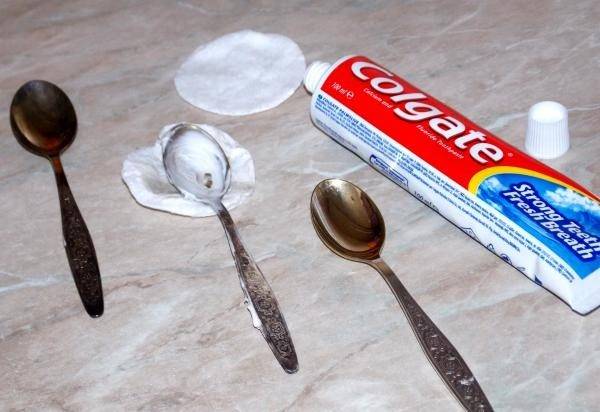
Apply toothpaste to a cotton pad and wipe down the appliances
How to clean gilded appliances
For chic gold-plated appliances, there are some simple ways to remove dirt:
- Wipe the gilding with a piece of cotton wool dipped in wine vinegar or turpentine.
- Rub cupronickel cutlery with gilded egg white applied to a flannel cloth.
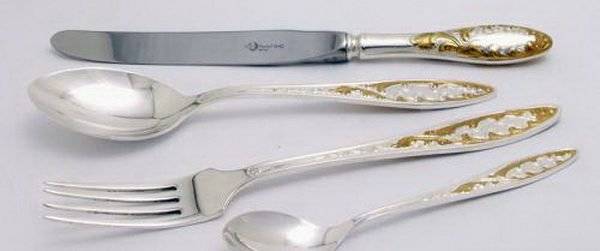
Gilded appliances are cleaned with wine vinegar, turpentine or egg white
Industrial methods and tools - which are suitable
When "homemade recipes" do not inspire confidence or do not give the expected effect, it is worth trying special preparations developed for the care of cupronickel surfaces. With their help, it will be faster and better to clean cutlery from dirt, but only if the manufacturer's instructions are followed. The most famous remedies:
- Gel "Sif";
- Emulsion "Amethyst";
- Polymet paste.
Paste products for cleaning stainless steel kitchen surfaces without abrasive particles are also suitable. For delicate processing of handmade products or jewelry, jewelry pastes are used that cannot damage their surface.

As a more practical and affordable alternative to silverware, cupronickel products are unrivaled. Sets of spoons, forks and knives made of this metal look solid and graceful, but only when they shine with cleanliness, do not have any plaque or streaks. Keeping your appliances shiny and tidy is easy with regular maintenance.
Rule number one for cupronickel devices is correct storage only in dry form. Spoons, forks and knives should be stored in a clean and dry place in the vicinity of the same cupronickel products. Additionally, you can use foil or paper to protect the devices from humid air.
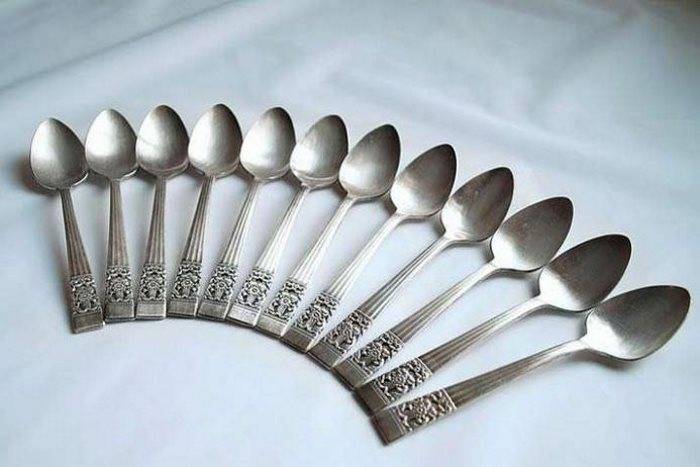
It is equally important to timely clean cupronickel spoons from darkening, followed by rinsing with warm water. Under no circumstances should the devices be left to dry in the dryer.
After processing, it will be correct to dry them delicately with a soft towel and sand with flannel.
It is recommended to regularly polish cutlery and utensils for special occasions and store them in special cases, separate from the sets for daily use. It will be appropriate to polish them every 2-3 weeks. The easiest way to do this is to use a special polishing paste. A more affordable and cheaper analogue is chalk powder mixed with grated laundry soap. Do-it-yourself paste is used to process products, rinse and dry.
Cupronickel appliances are used for table setting in public catering and home environments. The material is quite capricious, requiring special attention. Cutlery is cleaned according to certain rules using special tools.

